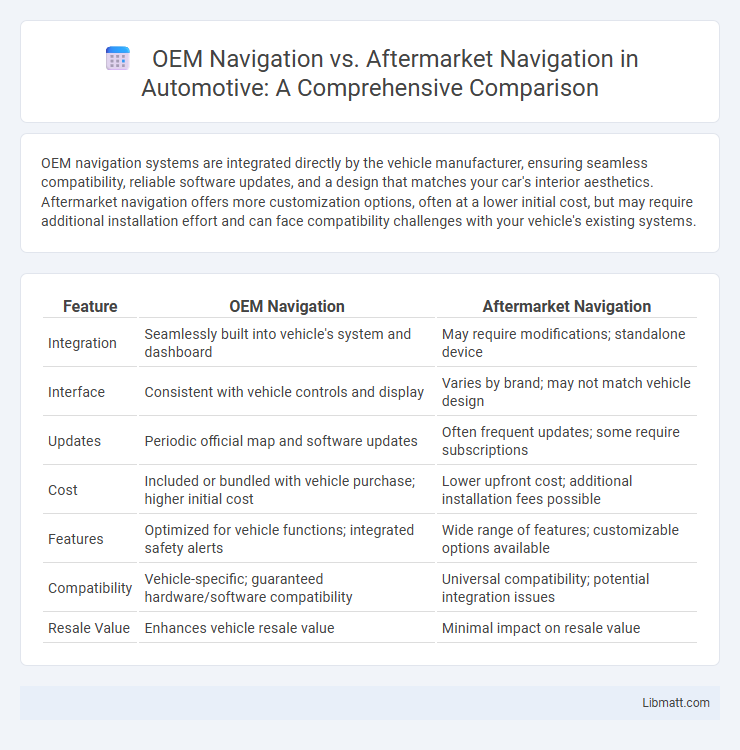OEM navigation systems are integrated directly by the vehicle manufacturer, ensuring seamless compatibility, reliable software updates, and a design that matches your car's interior aesthetics. Aftermarket navigation offers more customization options, often at a lower initial cost, but may require additional installation effort and can face compatibility challenges with your vehicle's existing systems.
Table of Comparison
| Feature | OEM Navigation | Aftermarket Navigation |
|---|---|---|
| Integration | Seamlessly built into vehicle's system and dashboard | May require modifications; standalone device |
| Interface | Consistent with vehicle controls and display | Varies by brand; may not match vehicle design |
| Updates | Periodic official map and software updates | Often frequent updates; some require subscriptions |
| Cost | Included or bundled with vehicle purchase; higher initial cost | Lower upfront cost; additional installation fees possible |
| Features | Optimized for vehicle functions; integrated safety alerts | Wide range of features; customizable options available |
| Compatibility | Vehicle-specific; guaranteed hardware/software compatibility | Universal compatibility; potential integration issues |
| Resale Value | Enhances vehicle resale value | Minimal impact on resale value |
Understanding OEM Navigation Systems
OEM navigation systems are integrated directly into a vehicle's factory-designed infotainment setup, ensuring seamless compatibility with hardware and software while maintaining warranty coverage. These systems typically offer optimized GPS accuracy, smoother user interfaces, and vehicle-specific features such as real-time traffic updates, voice command integration, and safety alerts. In contrast, aftermarket navigation solutions may provide broader customization and updates but often lack the precision and reliability inherent to OEM installations.
What Are Aftermarket Navigation Systems?
Aftermarket navigation systems are GPS devices installed in vehicles post-manufacturing, offering customizable features and updated maps independent of the original equipment manufacturer (OEM). These systems often provide enhanced touchscreen interfaces, smartphone integration, and real-time traffic updates compared to OEM units. They serve as cost-effective upgrades or replacements, especially for cars lacking built-in navigation or requiring advanced functionality.
Key Features: OEM vs Aftermarket Navigation
OEM navigation systems offer seamless integration with your vehicle's existing hardware, providing features like real-time traffic updates, voice command compatibility, and manufacturer-specific maps optimized for your car's display. Aftermarket navigation units often provide enhanced customization options, broader compatibility with multiple vehicle models, and frequently updated maps through third-party services. Your choice depends on whether you prioritize factory-supported reliability and interface or flexible features and upgrade potential.
Installation Process: OEM vs Aftermarket
OEM navigation systems integrate seamlessly with a vehicle's existing dashboard and electrical setup, offering a factory-calibrated installation that maximizes compatibility and reduces potential wiring issues. Aftermarket navigation units often require custom fitting, additional wiring harnesses, and possible modification of the dashboard, leading to a more complex and time-consuming installation process. Professional installation is typically recommended for aftermarket systems to ensure proper integration with vehicle functions such as steering wheel controls and backup cameras.
Cost Comparison: OEM vs Aftermarket Navigation
OEM navigation systems typically have higher upfront costs due to integration and brand-specific features, often ranging from $800 to $2,000 depending on the vehicle model. Aftermarket navigation units generally offer a more budget-friendly option, with prices between $150 and $600, while providing flexible upgrades and compatibility across multiple vehicle brands. Installation costs also vary, with OEM units usually installed by dealers at a premium, whereas aftermarket systems can be self-installed or professionally mounted at lower rates, influencing the overall cost comparison.
User Interface and Ease of Use
OEM navigation systems offer a seamlessly integrated user interface designed specifically for your vehicle, ensuring intuitive controls that match your dashboard layout and maintain consistent responsiveness. Aftermarket navigation systems provide customizable interfaces with advanced features but may require a learning curve and periodic adjustments to fit various vehicle models. Your choice depends on whether you prioritize plug-and-play convenience or enhanced customization and feature flexibility.
Map Updates and Software Support
OEM navigation systems typically offer seamless map updates integrated with your vehicle's software, ensuring compatibility and real-time accuracy, often through over-the-air updates or manufacturer service centers. Aftermarket navigation devices may require manual updates via USB or Wi-Fi, and software support can vary widely between brands, sometimes lacking consistent updates and customer service. Choosing OEM navigation ensures a smoother experience with reliable software support and timely map updates tailored specifically for your vehicle model.
Integration with Vehicle Functions
OEM navigation systems offer seamless integration with vehicle functions such as climate control, reverse cameras, and steering wheel controls, providing a cohesive user experience. Aftermarket navigation units often require adapters or additional wiring, which can lead to limited compatibility with existing vehicle features. This integration disparity impacts the ease of use and overall functionality during driving.
Warranty and Technical Support Differences
OEM navigation systems are backed by the vehicle manufacturer's warranty, ensuring comprehensive coverage and direct support from dealership technicians trained specifically for the vehicle model. Aftermarket navigation units typically come with limited warranties provided by the third-party manufacturer, which may not cover compatibility issues or integration problems with the vehicle's original electronics. Technical support for OEM systems is streamlined through authorized dealers, whereas aftermarket systems often require contacting separate vendors, potentially leading to longer resolution times and less specialized assistance.
Choosing the Best Navigation System for Your Needs
OEM navigation systems offer seamless integration with your vehicle's existing hardware and software, providing a user-friendly interface and reliable updates specifically tailored to your car model. Aftermarket navigation systems often deliver advanced features, broader compatibility, and customization options that may better suit your specific travel preferences or budget. Evaluating your priorities such as ease of use, feature set, and long-term support helps you choose the best navigation system for your needs.
OEM navigation vs Aftermarket navigation Infographic

 libmatt.com
libmatt.com